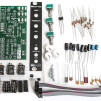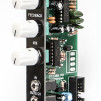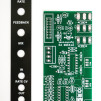Important Links
Product Page
Store Page
Assembly Instructions
Bill of Materials
Schematic
Capacitor and Resistor Lookup Guide
 |
 |
 |
The ECHO (formerly known as EKO) is a very unique echo using the PT2399 IC featuring Voltage Controlled Rate. Manual controls for Rate, Feedback, and Mix. Beautiful and bizarre, CV modulation of the rate brings in ghostly pitch bent sounds to metallic reverbs. An effects module that everyone needs in their rig.
Product info:
- Rate range: 30-190mS
- 4HP
- Voltage-controlled rate
- Self-oscillating feedback
- Mix control
- Hand-assembled in Portland, Oregon



Sounds lovely. However it seems like there’s enough panel space to provide VC feedback.
Would be nice not to surrender a VCA. Perhaps an Echo II ??
Hello, I just have a quick question before this PCB shows up for me to assemble 🙂 looking at the schematic, I don’t see where you put the 5V regulator at, but I assume you’re powering it through the +/-12V rails just like the DIRT filter correct? It would seem kinda redundant to pull it from the eurorack 5V rail, but I just want to make sure so I know if I need to rig up a 5V power supply before it arrives or get ready to cut some traces haha.
Hi Emu, there is a 5v regulator, but no need to connect it to the +5 rail.
We have a new delay module that is coming out soon, that has cv over feedback and a true wet/dry mix.
@Steve Harmon
That sounds wonderful – any news on this upcoming module?
Pretty close to finished! Look for it in the next couple months. If you’re signed up for our newsletter, we’ll keep you posted on it.
Hi, great new about the new delay. I love my 2x EKOs (why did you change the name?)
Question 1. Is it normal that the mix knob introduces feedback? Seems like both knobs are combined a bit?
It would be great if the new unit gave single delays when there is no feedback. Great to have CV feedback!
Question 2. Will it give a bit longer delays or are you still using PT2399? EKO is great for metallic ringing delays, less so those ambient lush delays…
Question 3. Another suggestion … sorry… Would be nice to have separate out for delay (totally removed input) and mix knob, or normalled socket. So that you could patch 2 into each other and get stereo bouncing shit…
Hi Mark, we changed it because of a legal challenge to the name.
Q1: We have a new module (coming soon) called the DLY that has a true wet/dry mix.
Q2: Yes it is the PT2399, it just gets weirder and distorted the longer you go
Q3: THE DLY should be able to do this
The ECHO is a great addition to any Eurorack setup. There’s no shortage of unusual effects you can squeeze out of this gadget. After building the first one and hearing what it can do, I ended up buying another one. Freakishly twisted sounds from the Twilight Zone escape from this doodad when activated. The kit was very easy to build and it’s the best bargain I’ve seen for a DIY Eurorack effects module. Highly recommended.
Hello,
In the schematic, I don’t see the TL074 power pins. Does these are connected to +12V/-12V ?
Sorry for my bad English
Hey There,
You are correct. Pin 4 should get +12v, and pin 11 should get -12v
Best,
-patrick at Synthrotek
hello,
there is someway to get 100% wet signal from the EKO module? some mod or hack?
The ECHO doesn’t have a 100% wet or dry signal, however the DLY module does. We don’t have a hack or mod for this, just the DLY.
Lovely echo module. Sounds great with a sine wave on a slow attack setting. Some far out stuff in the extreme dial settings. Watch your monitors for feedback!. Very easy to build as Synthrotek provide excellent BOM and build instructions, in addition, all the components are connected to a cardboard strip in the order of build. Genius!! Why can’t all DIY kit suppliers do that?
Thanks Christian!
This feedback is much more welcome than the kind blasting through monitors 🙂
Our company certainly takes pride in making the DIY experience enjoyable and I’ll pass this on to our kitters as late-day smile boost.
Thanks,
Michael
Hallo,
is it possible to use this circuit on a +15V/-15V-5V source without making any changes? If not could you please tell me what changes have to be done to get it work? I thought about changing R1 and R2 (120K to 150K) am I right with this?
Thanks alot for support.
Hi Thorsten, no 5v needed and folks have been using this in FRAC in the past, I don’t think any modifications are needed!